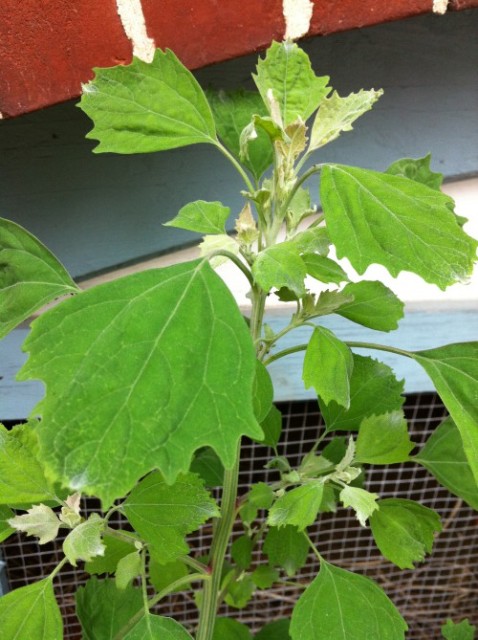Food grows on trees … and out of the sidewalk (but don’t eat it out of the sidewalk)
Maybe it says something about my preoccupation with food, but I’ve always been interested in which plants you can eat and how to prepare them. As a kid, I’d often chew on the lemony leaves of wood sorrel, although back then I was under the impression that this heart-leaved plant was clover, an illusion apparently shared by most people.

Yellow woodsorrel (Oxalis stricta). This is not a clover.
By 6th Happiness [CC-BY-SA-3.0 (http://creativecommons.org/licenses/by-sa/3.0)%5D, via Wikimedia Commons
One of yellow wood sorrel’s common names is “lemon clover,” which doesn’t help, especially since this variety grows all over the place as a weed. Real clover looks like this:

White clover, Trifolium repens
Forest & Kim Starr [CC-BY-3.0 (http://creativecommons.org/licenses/by/3.0)%5D, via Wikimedia Commons
Remember that scene in “Bambi” when they were eating the clover flowers? Those things are delicious.
Even if you’ve repressed the memories of that particular movie because of what happened to Bambi’s mom, it’s easy to tell wood sorrel and clover apart when you know what they are. Wood sorrel has three heart-shaped leaflets; clover leaves look like the symbol for the suit of clubs, with three oval leaflets, and often each leaflet has a little pale-green arc facing inwards. Wood sorrel has more stereotypically “flower”-looking flowers with five petals, and, later, seedpods that look like tiny okra (you can eat the seed pods while they’re green); clover has a raceme (a flower spike) with a clump of tiny flowers that are often white, pink, or mauve, depending on the species.
The great thing about these two plant types, though, is that they’re both edible and they’re both everywhere, so even if you can’t figure out which is which for some reason, you can still chow down. If nothing else, you’ll know as soon as you bite into one; wood sorrel is tangy, while clover is pretty mild, with those sweet compound flowers. You can make tea or salad out of both of them, and dried clover flowers are often sold in health food stores as a dietary supplement.
A plant I’ve discovered much more recently thanks to John Kallas’s excellent book, Edible Wild Plants: Wild Foods from Dirt to Plate, is lamb’s quarters, which Kallas refers to as wild spinach. Since I’ve learned what it was, I’ve found it growing all over the place, including right in front of my house:
A waxy coating covers the leaves and stems, and you have to wash that off before you cook them or the texture is weird; however, once that’s done, the plant apparently makes a great steamed vegetable. I’ve only cooked it in combination with other things, since I haven’t found enough of it to eat it by itself.
Other edible weeds include dandelion, sow thistle, purslane, and plantain (this is that plant with the flattened whorl of leaves that grows along sidewalks and sends up a long green seed spike, as opposed to the banana-like plant featured in African and Caribbean cooking; you can eat the green seeds and the leaves of the weedy one). In fact, there’s a host of edible plants growing all around you, once you start looking. Most weeds are, by definition, plants that thrive in disturbed habitats, often near human activity. This actually makes me sad most of the time: I live in a city, and most of these plants and the soil they grow in are probably contaminated with one thing or another, whether it’s heavy metals, pesticides, or doggie doo. Every time I walk past an abandoned lot, it’s like being in a greengrocer where you can’t eat any of the food. But I’ve stopped uprooting and throwing out the purslane, wood sorrel, and lamb’s quarters that grow in my garden plot, and instead have started using them in my food. They do better than many of my vegetables anyway, and are less of a headache to cultivate.
If you want to learn more about edible plants, check out Kallas’s book, as well as the more encyclopedic Nature’s Garden: A Guide to Identifying, Harvesting, and Preparing Wild Edible Plants, by Samuel Thayer. If you want a good online resource for starting out, take a look at Eat The Weeds, run by the sometimes codgerly Green Deane, who provides a lot of interesting information.


